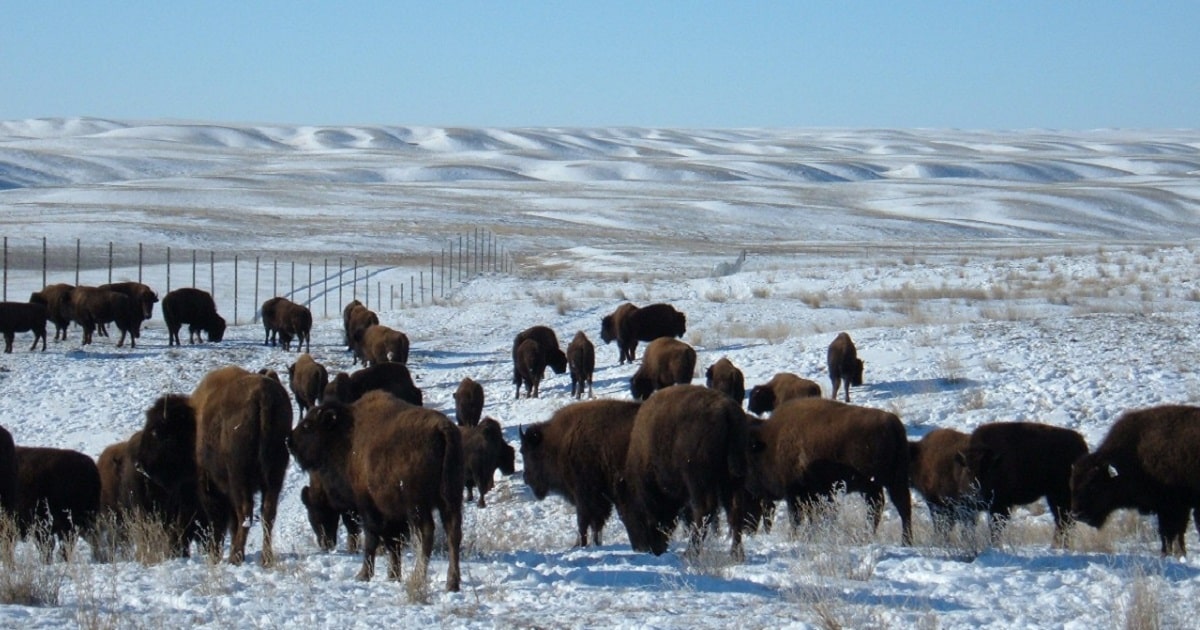The Key First Nation, Welcomes Home Bison Herd Back To Treaty 4 Land
- TDS News
- Eastern Canada
- Indigenous
- Trending
- February 1, 2022

Mashkode-bizhiki | Plains bison herd successfully re-established to The Key First Nation in Saskatchewan
Today, the Honourable Steven Guilbeault, Minister of Environment and Climate Change and Minister responsible for Parks Canada, and Jennifer McKillop, Saskatchewan Regional Vice-President for Nature Conservancy of Canada, announced that 40 plains bison were successfully translocated to establish a new herd with The Key First Nation in Treaty 4. This marks a historic moment for The Key First Nation; a nation that has worked closely with Parks Canada and the Nature Conservancy of Canada to return these culturally significant animals to their traditional lands.
Bison are an iconic symbol of the grasslands and, once numbered in the tens of millions, were relied upon as a staple part of the lives of Indigenous peoples. The near-extinction of bison – culminating in the 1880s due to over-hunting – resulted in economic, spiritual and cultural devastation for Indigenous peoples on the Prairies. A total of 20 plains bison from Grasslands National Park and 20 from Old Man on His Back Prairie and Heritage Conservation Area (OMB) in Saskatchewan have been successfully translocated to The Key First Nation’s lands. With this transfer of animals, The Key First Nation, Parks Canada and NCC are working in collaboration toward the survival and well-being of these iconic and majestic animals.
Returning mashkode-bizhiki to The Key First Nation advances Indigenous-led conservation of a threatened species, including through Indigenous ecological knowledge, partnerships between nations and stakeholders, and improved cultural and socio-economic opportunities for the Anishinaabe people.
“Repatriation of bison is the true cultural revitalization piece for our Anishinaabe people immediately creating unity and togetherness within the community chi-miigwech.” Christopher Gareau
Councillor for The Key First Nation
“The near extinction of plains bison was a devastating loss for Indigenous peoples across the Great Northern Plains. This collaboration with The Key First Nation to return plains bison to their land is a positive example of Parks Canada and Indigenous peoples working together and taking important steps toward conserving natural and cultural heritage, and sharing the stories of this majestic animal.” The Honourable Marc Miller
Minister of Crown-Indigenous Relations
“Indigenous peoples of North America lived alongside bison for thousands of years, and in many Indigenous cultures, bison and humans are inextricably linked. The grazing patterns of bison also help shape the vegetation composition, ecosystem function and structure of the Prairies. Partnerships with Indigenous communities are a vital part of NCC’s work as a land conservation organization. We strive to ensure that collaborating with Indigenous peoples becomes a routine part of our conservation work. We are honoured to help establish a plains bison herd for The Key First Nation.” Jennifer McKillop
Saskatchewan Regional Vice-President for Nature Conservancy of Canada

The Key First Nation homeland is part of the territory covered by the terms of Treaty 4 (1874), located in Norquay; part of the Fort Pelly district in eastern Saskatchewan.
Over the past decade, Grasslands National Park staff have worked closely with Indigenous communities that have applied to receive bison to bring this culturally significant animal back to their traditional rangeland, while also facilitating cultural or socio-economic opportunities. Any Nation interested in this opportunity is encouraged to contact Grasslands National Park for more information.
In 2003, a group of 50 plains bison calves were translocated from Elk Island National Park to OMB, where plains bison had once roamed in the thousands but had almost become extirpated (locally extinct) in the early 1900s.The herd provides visitors to OMB the opportunity to safely view plains bison in their natural habitat.
An additional 10 plains bison will be selected from Grasslands National Park and translocated to OMB this winter, to supplement the herd. Working together with Indigenous Nations and conservation partners allows for both the establishment of new herds, while managing existing populations to maintain sufficient grazing land, and the protection of vegetation communities and rangeland for other species.








